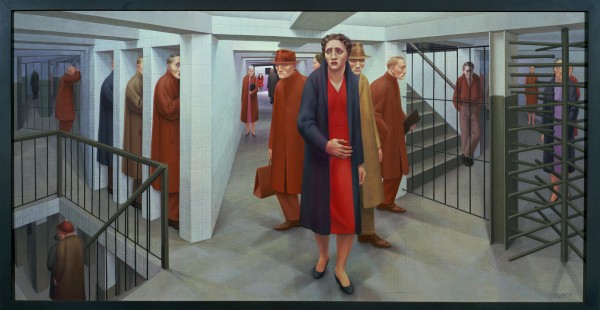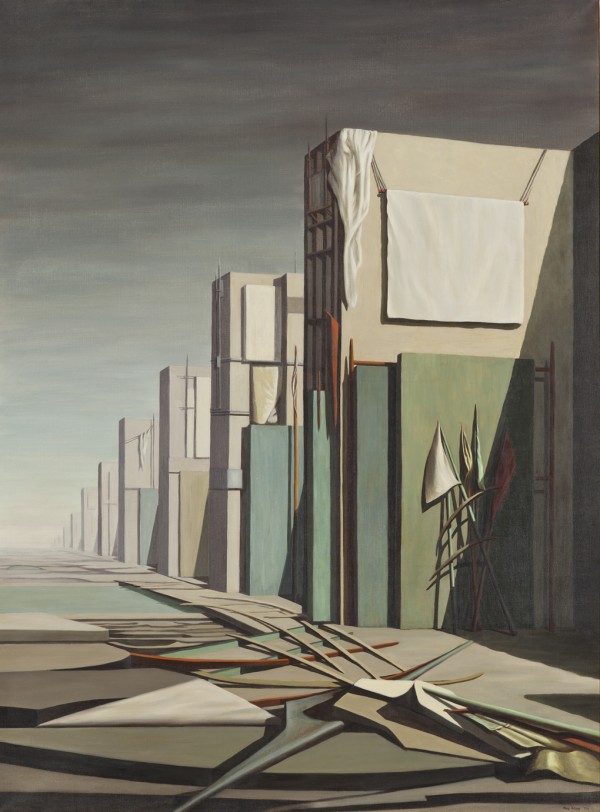
“Real/Surreal” is the newest exhibit at the Akron Art Museum
“Real/Surreal,” the latest display mounted by the Akron Art Museum, a Knight Arts grantee, goes all out to answer the question about the transition in art history from fastidiousness with realism as a technique to the exploration of the surreal.
What’s the difference, you ask? Good question. Technically, realism gives us a credible depiction of our world (something like you might expect, as artists have, to get from a camera). It also focuses on the colors of nature and familiar light and shade patterns, along with a traditional use of perspective for suggesting distance and things close up.
The surreal, as you probably can guess, up-dumps all that when it appeared as an artistic movement. And it all makes for some unsettling illustrations of the world and the people in it that just don’t quite jibe.
The exhibit, which draws extensively from the Whitney Museum of American Art (along with some private pieces and a few of AAM’s own), pulls together paintings with prints, photographs, lithographs and etchings that show the pervasiveness of the artistic need to explore – to be liberated in a way, as it were.
A couple of examples help tell it all. Take Philip Evergood’s “Lily and the Sparrows,” an oil work on composition board. The artist, while walking down a street, looked up and saw a young girl peering out an apartment building window while birds flew by.
Philip Evergood, “Lily and the Sparrows,” from the collection of the Whitney Museum of American Art. Photo courtesy of Akron Art Museum
There’s a way to depict all that realistic, to be sure, but Evergood went the surreal way. Lily, the young girl, is drawn with an outsized head and an odd expression. It may be a good likeness (for realists were awfully good at drawing and the rudiments of academic art), but when done extra large against a vivid, too-red building, with birds flying not in a sensible pattern, it takes on an unsettling tone (much like the underlying threat of dolls come to life in a current horror film or film about possession). A menacing oddness prevails.
Maybe another way to distinguish the real from the surreal in art is to take a work and imagine a rather realistic likeness of you (done to scale of course) placed into the work. Who would look out of place? You would, or probably should.
Such might be the case with George Tooker’s “The Subway,” an egg tempura work on composition board. If you were in it, you’d look alien next to the stiff and rather oppressed looking characters in the image, where the ceilings seem mighty low and the scale and perspective slightly stifling and harsh. In terms of the work as done, it all works together – evoking wholeness through mood and feeling and point of view despite its brand of unreality.
George Tooker, “The Subway,” from the collection of the Whitney Museum of American Art. Photo courtesy of the Akron Art Museum
One thing about the AAM exhibit – the more famous artists like Grant Wood, Andrew Wyeth and Edward Hopper, all of whom were well known as realists, take their turn at surrealistic elements, yet they don’t outshine lesser known artists, like photographer Andreas Feininger and painter Kay Sage (whose “No Passing” reveals a disorderly ordered world).
Kay Sage, “No Passing,” from the collection of the Whitney Museum of American Art. Photo courtesy of the Akron Art Museum
“Real/Surreal” will be on exhibit through November 3 at the Akron Art Museum, One South High St., Akron; 330-385-8196; www.akronartmuseum.org. Hours are 11 a.m.-5 p.m., Wednesday-Sunday, with extended hours until 9 p.m. on Thursday. Admission is $7.
Recent Content
-
Artsarticle ·
-
Artsarticle ·
-
Artsarticle ·



